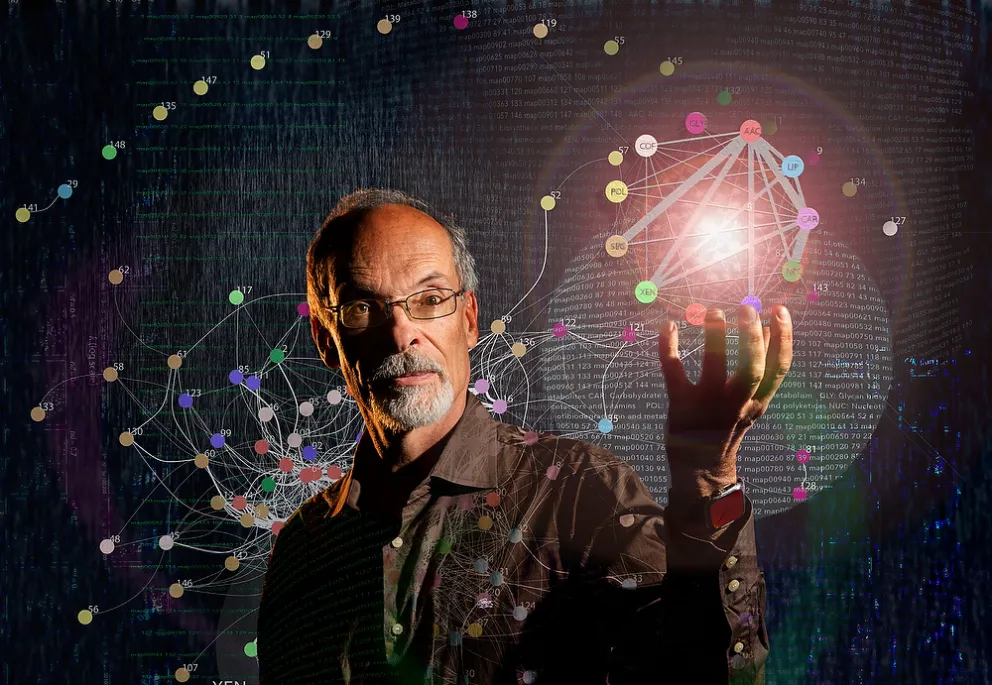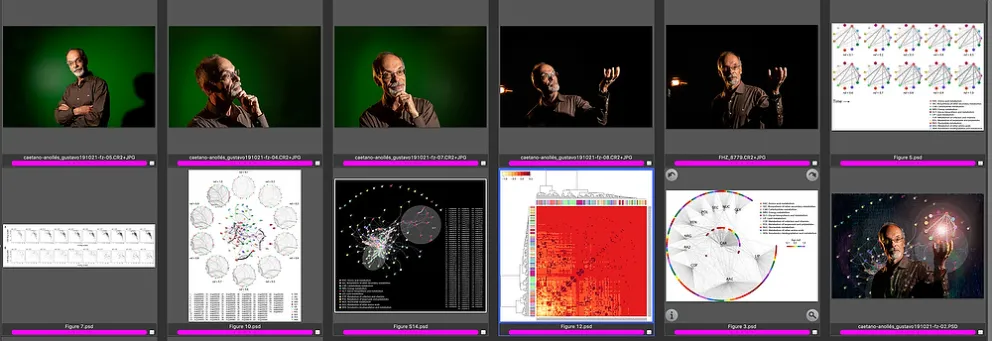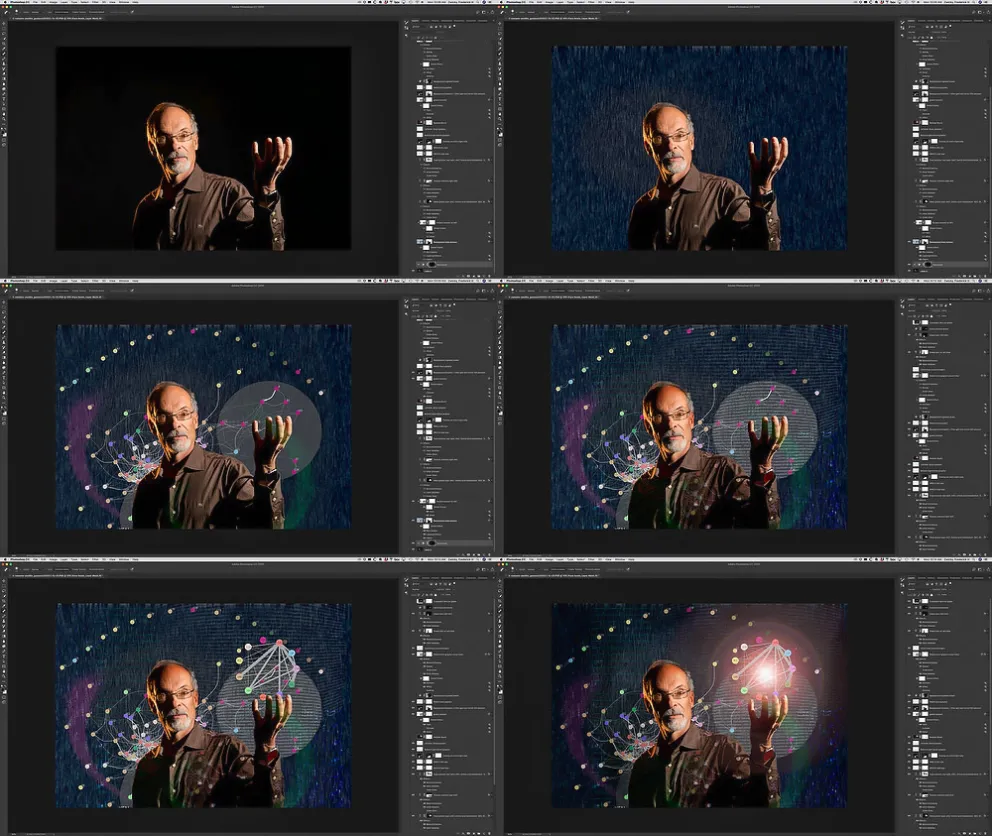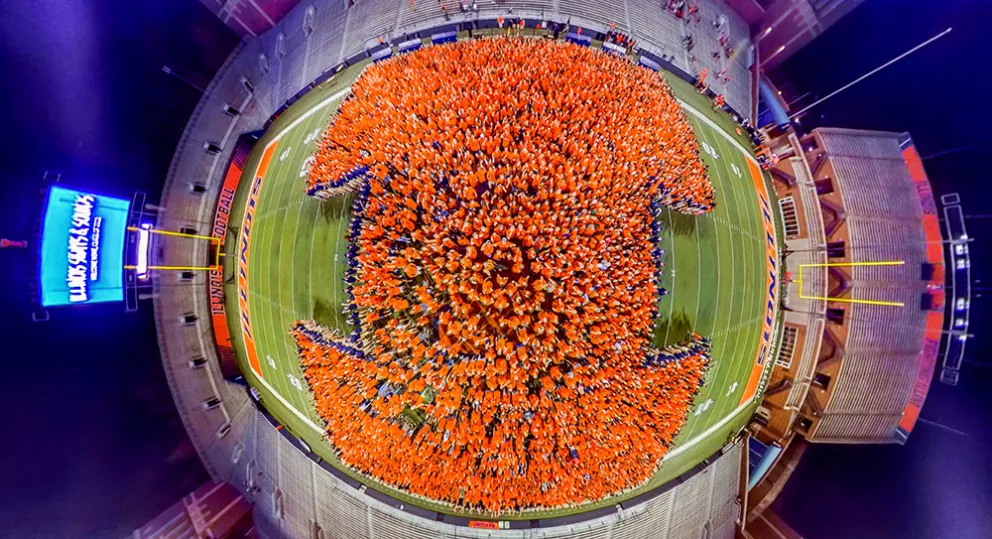
(text and photos by Fred Zwicky) Fred Zwicky’s Features & Illustrations category image “Mastering Energy and Matter” was voted Best in Show in the November 2019 Monthly Image Competition.
Fred is senior photographer at the University of Illinois at Urbana-Champaign. He’s been on staff at Illinois for a little less than a year and joined UPAA practically on day one. Like many, he had a career in newspaper photojournalism, most recently at the Journal Star in Peoria, IL. He has also taught photojournalism and video storytelling for nearly 20 years at Bradley University in Peoria.
Quick tech stuff: Camera, focal length, exposure data, lighting used (if any):
• Canon 5D Mark IV, 24-70mm at approx. 55mm
• ISO 100, 1/125 @ f8
• Lighting: Two AD200 flashes
Main light (round head with grid): I always try to light up both eyes with the main light. Pleased that I just caught the tiniest, slightest sliver of the far eye.
Rim light (fresnel head with barn doors and grid): I added a 1/2 straw filter (held on by clothes pins). Note: you can see the rim light in one of the contact sheet frames.
Assignment or found/self-assigned? Any unique logistics in making the photo? What sort of post-processing (or not)?]
BACKGROUND
This particular image was the result of a News Bureau assignment. The University of Illinois is a major research institution. Case in point: eight of the most influential researchers globally for the last decade call the University of Illinois home. The job for our writers is to decode the research lingo into something we mere mortals can understand. As a storyteller sort of guy, I always try to weave visual elements that convey their work into the image. If their work produces something physical, fantastic. If I can photograph them in action in the field or lab, even better. I usually try to research the researcher. I skim through their research paper looking for ideas, do deep web searches and then try to brainstorm. However, many times the work is so theoretical that it is impossible to photograph their research in a physical way.
This was true for the work of bioinformatics professor Gustavo Caetano-Anollés. If I told you literally what the research paper said, you would have an immediate and long-lasting brain freeze. Fortunately, our writer, Diana Yates, was able to translate his work to this: Gustavo has mapped the way living creatures have evolved in how they handle matter and energy over the history of time.
Wow! Try to photograph that.
SHOOT LOGISTICS
I knew there were graphs related to his work, but they had not been published yet. And, as it turns out, I was going to have to wait until I met with him to see them. My hope was that we could project a research graphic over his work space to create a nuanced shot. I've projected images over scenes lots of times. In the old days, I used multiple slide projectors (!) and then used gaff tape to mask out areas for the subject's face. Royal pain. Now you can just load up a graphic in Photoshop as you project and paint on a layer mask to block out areas for your subject. Or perhaps I could do some in-camera multiple exposure magic! Because after all, as we all know, getting that in-camera image is the macho thing to do.
However, once I saw the graphics at his office, I just didn't feel like they gave any sense of the magnitude of what his work represents. We're talking about how life evolves and adapts matter and energy over the history of time. This is God material here.
I immediately bailed on the standard approaches. I decided I would extract elements of the graphics and weave them into the final shot in post. Call it lazy if you want. Call it a cheat. I would just say that this story demanded another approach.
With this in mind, now all I needed for the shoot was some dramatic directional light and a clean background. Off to his department's virtual classroom for a blank wall.

Above: The raw materials before post-processing
POST
OK, shot is in the bag, but the image is not. I've just painted myself into a box. I'm a photojournalist by nature and my only option now is to create the visual universe myself. A little Photoshop purgatory for me. What will he hold in his hand? Not sure yet. However, it's good to stretch new muscles (kind of like switching jobs).
My idea was to create sweeping circular arcs around the subject, layer other elements as textures, and then have him hold up the results of his research like some sort of gift to the heavens. I cut out the raw text from his data charts and used extreme text warping to create the right side globe. I wove in visual elements from his graphics, making them more organic by adding layer styles, smart filters, blend modes and lots of masking to add dimension and depth. I even added a graphic to his watch face. Once you start on a riff, it's hard to stop.

Above: Just a handful of the many many layers involved in the final image
The response to the image has been spectacular. I'm hoping it helped people connect to Gustavo's work.
When I told (Director of Photography) Brian Stauffer about the MIC, he referenced Greg Heisler, who speaks about “The Appropriate Response.” I'm hoping that on this shoot, going full-bore illustration was that appropriate response. However, to be honest, I did run out and shoot a good old-school documentary-style shoot later that month. This fish needs his water.
What (if anything) would you do differently if you could re-shoot this today?
I would light his upper hand separately with a gridded backlight to match the direction of light from the glowing orb.
Where do you look for feedback, inspiration and/or motivation?
If I want love, I post images on social media. People love pictures, so it’s nice to feed an appreciative and ever-hungry beast. Plumbers are more important than us picture guys, but I’m thinking the world is probably better off if plumbers don’t post their work pictures.
If I want a critique, honestly, it’s always me and my inner dialogue. I once received a brutal critique from legendary videographer Darrell Barton at an NPPA News Video workshop. After his teardown, he asked if I’d ever been hammered worse. I told him that he doesn’t lay his head down on my pillow with my thoughts at night. (And no, I was not propositioning Darrel Barton!)
If I want motivation, I just have to look at the work of UPAA members. Legit. You all are kicking my butt.
For me, I find inspiration when my standard photo approach isn’t the right answer. You know the feeling: The shot is passable, but not awesome. Most times, that feeling results in an act of desperation in the moment. Good things can actually happen when we’re faced with the ordinary.
However, in my new job, it’s been great to bounce ideas off of Brian, our writers and our amazing social media team, who are crazy enthusiastic and fun. No kidding – laughter is literally reverberating down the hall from their offices as I type. That’s a daily event. So, a fun environment really helps.
I’ve found that if I bounce ideas off of them verbally, it leads to me going all stream-of-consciousness, leading to some new twisted variation of the original idea. Many times I don’t know if it will work or not, but I’ll give it a go. If perhaps you saw my freshman class group shot as a tiny planet, that would be an example, or this mirror idea for a seed researcher.

Where's Waldo...er, Fred? He used a 360 camera to get a unique bird's-eye view of the freshman class forming the letter "I" earlier this year. The camera does not see the support boom. To make the photo Fred had to be *in* the photo!
I’m working on a couple more right now for the holiday. We’ll see how those turn out (or not). It’s awesome in this new world of university work, you can approach images in a much less literal way than in the daily news business.
What would your dream job/project be?
I think a dream job would have these elements:
• You have an appreciative audience for your work that is always hungry for more.
• You have the resources to do good work.
• You get to tell visual stories in many different ways.
• Your images help people celebrate what it feels like to be alive; sharing moments of love, laughter, loss, hope and the struggle to be something more than what we are now.
I’ve never had the perfect job. But, I’ve always strived to make wherever I am look like it actually is that perfect job. I’m just about one year into this U. of I. position. It’s not perfect, yet. But, most of that falls on me. I’ll keep working on it.
_____________________________________________________________
“I’m reading a book about anti-gravity. It’s impossible to put down!” Got an idea for the blog? Send submissions, critiques--or jokes--to editor Matt Cashore, mcashore@nd.edu. And follow UPAA on Instagram, too!